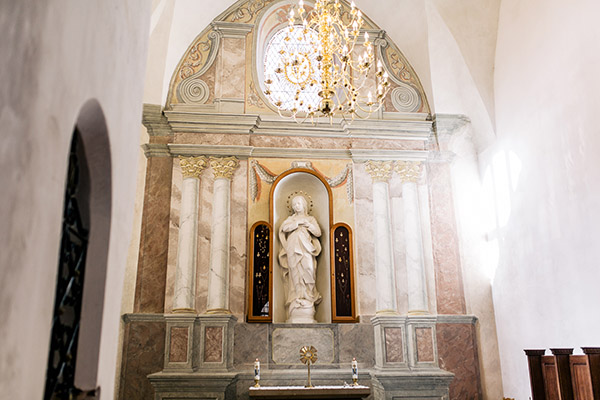
This Church is included as part of the following itineraries: Places of Marian Devotion, the Route of the Franciscans.
Archaeological investigations revealed that the location on Traku Street, where the Franciscan Conventual Friars Church stands, is one of the earliest locations in Vilnius where Catholicism was practiced. Archaeological finds at this location provide evidence that Christian burials at this site predate the construction of the first masonry church, built here at the end of the 13th century. Like most of the churches built by Grand Duke Vytautas and King Jogaila, this Franciscan Church is dedicated to the Assumption of the Blessed Virgin Mary. Its name is also written with the appendix “in Arena”, i.e. “Smiltyne” referring to its location in the City.
In 1390, during crusader attacks on Vilnius castles, the Franciscan buildings were burned. In 1421 a new Church and monastery were built. More fragments of valuable monastic architecture, predating the 18th century, can be found in the Church than in the monastery. After the uprisings of the 19th century, the Church and monastery were closed, and the richly stocked library was taken away. Archives were established in the Church during the Soviet years, and in 1998 the Church was returned to the Conventual Franciscan Friars.
Near the fence, at the entrance to the Church and monastery grounds, there is a Baroque chapel of the Suzinu family, which was built to commemorate the residents of Vilnius who were killed by the Cossacks.
The Statue of the White Madonna, also known as the Blessed Virgin Mary of the Immaculate Conception, was renowned for its graces throughout the City from the 18th century. At that time the statue was displayed in the visitor hall of the monastery. Mary is depicted pregnant, as described in the Book of Revelation. It’s likely that’s why the White Madonna is considered the guardian of families, the peacemaker of dysfunctional families, an intercessor of childless families and the patron of unborn children. In 1864, when the Tsar closed the monastery, the statue of Mary was hidden by plastering it in a recess of the monastery wall. In 1935 the Franciscans moved the statue to the Church and displayed it in St. Lawrence Chapel. During the Soviet years, the Church was converted into a state archive warehouse. No one suspected that the White Madonna had been hidden again, plastered in a niche of the former Chapel. After the Church was returned to the Franciscans, the statue was uncovered once again.
Monday–Friday – 5.30 p.m.
Sunday – 10 a.m.
Monday–Friday – 7 p.m.
Sunday – 11.30 a.m., 1 p.m.




